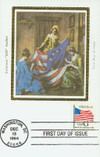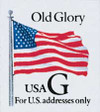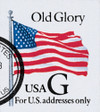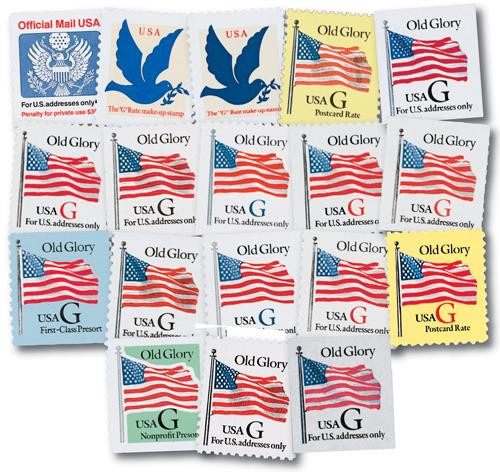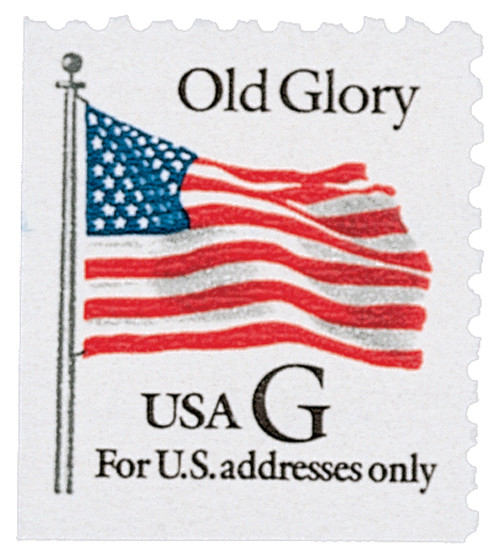
# 2886 - 1994 32c G-rate Old Glory, black "G", self-adhesive
U.S. #2886
1994 G-rate Old Glory
- Issued as a non-denominated stamp
- “Domestic” or “Domestic Use” was changed to “US Address Only” to clear up confusion for First Class Mail
Stamp Category: Definitive
Set: G Series
Value: 32¢ First Class Rate
First Day of Issue: December 13, 1994
First Day City(s): Washington, DC
Quantity Issued: 1,080,000,000 (1,077,998,400 in panes and 2,001,600 in coils)
Printed by: Avery Dennison Security Printing Division
Printing Method: Gravure Printing on a DNK 8-color webfed gravure press.
Format: Booklet and Coils. Panes of 18, arranged vertically 3 across and 6 down. In the middle is a peel-off strip. Gravure printing cylinders of 1,080 subjects (60 booklets, 10 across by 6 around). Coils of 5,004 stamps printed from 396-subject cylinders (11 across by 36 around).
Perforations: Die cut
Why the stamp was issued: The USPS issued this G series general-use stamp for the new first-class rate that would take place in 1995.
About the stamp design: This stamp was designed by Ronald Sharpe who was the first African-American Banknote Designer at the Bureau of Engraving and Printing.
Special design details: The USPS had a few other design ideas that would match the G rate stamp such as a goose, grapes and even George Washington, but they settled on “Old Glory.”
About the printing process: These stamps were printed on laminated paper and self-adhesive. These booklets of 18 were known as “convertible booklets.”
First Day City: Most definitive stamps that don’t receive a first day ceremony get issued in Washington, DC which is home of the United States Postal Headquarters.
About the G-rate Series: The USPS issued G-rate stamps to aid in the transition of a new postal rate. All, except two, G-rate stamps picture the US Flag with “Old Glory” in text above it, the other two are blue doves. They released eighteen different versions of G-rate stamps. These came in six different formats, in five varied rates, from five different printers! These include six different sheet stamps, six coils, four booklets, and two self-adhesives. This made the G-rate stamps printed by more printers and in more formats that any previous rate change stamp.
History the stamp represents: The US Postal Service started making rate change stamps, or “contingency” stamps as they were known, in 1978 with the A-rate which was fifteen cents. They wanted to make sure they had stamps to fulfill any rate change, gap in prices, or any combination. In early 1981 the B-rate stamps were issued to make up eighteen cents. At the end of 1981 the C-rate for twenty cents was issued. A few years went by before the D-rate came along in 1985. With the E-rate collectors saw a shift from an eagle with the color stamp to the image reflecting the letter, E having an Earth on the stamp in 1988. The F make-up-rate was only four cents and depicted a tulip on the stamp. G-rate was in 1995 and H followed in 1999. Collectors thought they were going to keep going following the rest of the alphabet, but H was where it ended. Many joked that the US Postal Service didn’t want to issue an I-rate stamp, but the reasons behind the end was never clear.
U.S. #2886
1994 G-rate Old Glory
- Issued as a non-denominated stamp
- “Domestic” or “Domestic Use” was changed to “US Address Only” to clear up confusion for First Class Mail
Stamp Category: Definitive
Set: G Series
Value: 32¢ First Class Rate
First Day of Issue: December 13, 1994
First Day City(s): Washington, DC
Quantity Issued: 1,080,000,000 (1,077,998,400 in panes and 2,001,600 in coils)
Printed by: Avery Dennison Security Printing Division
Printing Method: Gravure Printing on a DNK 8-color webfed gravure press.
Format: Booklet and Coils. Panes of 18, arranged vertically 3 across and 6 down. In the middle is a peel-off strip. Gravure printing cylinders of 1,080 subjects (60 booklets, 10 across by 6 around). Coils of 5,004 stamps printed from 396-subject cylinders (11 across by 36 around).
Perforations: Die cut
Why the stamp was issued: The USPS issued this G series general-use stamp for the new first-class rate that would take place in 1995.
About the stamp design: This stamp was designed by Ronald Sharpe who was the first African-American Banknote Designer at the Bureau of Engraving and Printing.
Special design details: The USPS had a few other design ideas that would match the G rate stamp such as a goose, grapes and even George Washington, but they settled on “Old Glory.”
About the printing process: These stamps were printed on laminated paper and self-adhesive. These booklets of 18 were known as “convertible booklets.”
First Day City: Most definitive stamps that don’t receive a first day ceremony get issued in Washington, DC which is home of the United States Postal Headquarters.
About the G-rate Series: The USPS issued G-rate stamps to aid in the transition of a new postal rate. All, except two, G-rate stamps picture the US Flag with “Old Glory” in text above it, the other two are blue doves. They released eighteen different versions of G-rate stamps. These came in six different formats, in five varied rates, from five different printers! These include six different sheet stamps, six coils, four booklets, and two self-adhesives. This made the G-rate stamps printed by more printers and in more formats that any previous rate change stamp.
History the stamp represents: The US Postal Service started making rate change stamps, or “contingency” stamps as they were known, in 1978 with the A-rate which was fifteen cents. They wanted to make sure they had stamps to fulfill any rate change, gap in prices, or any combination. In early 1981 the B-rate stamps were issued to make up eighteen cents. At the end of 1981 the C-rate for twenty cents was issued. A few years went by before the D-rate came along in 1985. With the E-rate collectors saw a shift from an eagle with the color stamp to the image reflecting the letter, E having an Earth on the stamp in 1988. The F make-up-rate was only four cents and depicted a tulip on the stamp. G-rate was in 1995 and H followed in 1999. Collectors thought they were going to keep going following the rest of the alphabet, but H was where it ended. Many joked that the US Postal Service didn’t want to issue an I-rate stamp, but the reasons behind the end was never clear.





